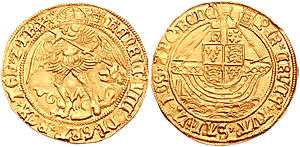Angel (coin)
| Angel gold coin | |
|---|---|
 | |
| The image of the Archangel Saint Michael slaying a dragon, the legend inscribed with HENRIC VIII DI GRA REX AGL & FR | The image of an English galley with the monogram 'H' and a rose set below the main topmast, the ship surmounted by a shield bering the King's arms, the legend inscribed PER CRVCE TVA SALVA NOS XPC REDE. |
| AV 29mm, 5.12 g, 8h. Mm: portcullis, London. First coinage, 1509-1526. | |
The angel was an English gold coin introduced by Edward IV in 1465. It was patterned after the French angelot or ange, which had been issued since 1340. The name derived from its representation of the archangel Michael slaying a dragon.[1] As it was considered a new issue of the noble, it was also called the angel-noble.[2]
In 1472, the half-angel was introduced with a similar design weighing 40 grains (2.6 grams) with a diameter of 20 to 21 millimeters.
Design
Reverse: Depicts a ship with arms and rays of sun at the masthead. Legend: per crucem tuam salva nos christe redemptor, meaning "By Thy cross save us, Christ Redeemer."
Value
The angel varied in value from 6 shillings 8 pence to 11 shillings between Edward's reign and the time of James I. Under Charles I, it was last coined in 1642.[1][3]
- In 1526 during the reign of Henry VIII, it increased to seven shillings and six pence (7 s. 6 d.) or 90 pence.
- In 1544, it increased again to eight shillings (8 s.) or 96 pence.
- In 1550 during the reign of Edward VI it increased to ten shillings (10 s.) or 120 pence or £½.
- In 1612 during the reign of James I it increased to eleven shillings (11 s.) or 132 pence.
- In 1619 it decreased to ten shillings (10 s.) and at that point in time it weighed 70 grains (4.5 g).
In 1663, Charles II replaced the existing coinage with entirely new designs struck by machine ("milled"). The standard gold coin then became the Guinea.
Social impact
The angel was such an iconic coin that many English pubs were named after it. The Angel Inn in Islington (after which the Angel tube station is named) was one of these.
The angel was traditionally given to sufferers of the disease known as "king's evil", in a mediaeval ceremony intended to heal them with the "royal touch". After it was no longer minted, medals with the same device (called touch pieces) were given instead.[2]
References
Citations
Bibliography
- "Angel", Encyclopædia Britannica, 9th ed., Vol. II, New York: Charles Scribner's Sons, 1878, p. 28.
- "Angel", Encyclopædia Britannica, 11th ed., Vol. II, Cambridge: Cambridge University Press, 1911, p. 6.
| Wikimedia Commons has media related to Angel (coin). |
.png)